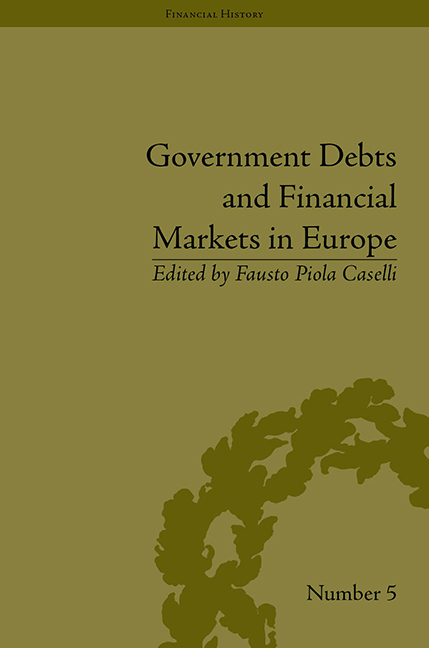Book contents
- Frontmatter
- CONTENTS
- Contributors
- List of Charts and Tables
- Introduction
- 1 The Financial Administration of North Hanseatic Cities in the Late Middle Ages: Development, Organization and Politics
- 2 Government Debts and Credit Markets in Renaissance Italy
- 3 Government Debts and Financial Markets in Castile between the Fifteenth and Sixteenth Centuries
- 4 Government Debt and Financial Markets: Exploring Pro-Cycle Effects in Northern Italy during the Sixteenth and the Seventeenth Centuries
- 5 Government Policies and the Development of Financial Markets: The Case of Madrid in the Seventeenth Century
- 6 The Role Played by Short-Term Credit in the Spanish Monarchy's Finances
- 7 From Subordination to Autonomy: Public Debt Policies and the Creation of a Self-Ruled Financial Market in the Kingdom of Naples in the Long Run (1500–1800)
- 8 Public Debt in the Papal States: Financial Market and Government Strategies in the Long Run (Seventeenth–Nineteenth Centuries)
- 9 Towards a New Public Credit Policy in Eighteenth-Century Spain: the Introduction of the Tesorería Mayor de Guerra (1703–6)
- 10 French Public Finance between 1683 and 1726
- 11 Long-Term War Loans and Market Expectations in England, 1743–50
- 12 Mercantilist Institutions for the Pursuit of Power with Profit: The Management of Britain's National Debt, 1756–1815
- 13 Italian Government Debt Sustainability in the Long Run, 1861–2000
- 14 Times of Wasteful Abundance: The Apogee of the Fiscal State in the Federal Republic of Germany from the 1960s to the 1980s
- Conclusion: Final Remarks
- Notes
- Bibliography
- Index
9 - Towards a New Public Credit Policy in Eighteenth-Century Spain: the Introduction of the Tesorería Mayor de Guerra (1703–6)
- Frontmatter
- CONTENTS
- Contributors
- List of Charts and Tables
- Introduction
- 1 The Financial Administration of North Hanseatic Cities in the Late Middle Ages: Development, Organization and Politics
- 2 Government Debts and Credit Markets in Renaissance Italy
- 3 Government Debts and Financial Markets in Castile between the Fifteenth and Sixteenth Centuries
- 4 Government Debt and Financial Markets: Exploring Pro-Cycle Effects in Northern Italy during the Sixteenth and the Seventeenth Centuries
- 5 Government Policies and the Development of Financial Markets: The Case of Madrid in the Seventeenth Century
- 6 The Role Played by Short-Term Credit in the Spanish Monarchy's Finances
- 7 From Subordination to Autonomy: Public Debt Policies and the Creation of a Self-Ruled Financial Market in the Kingdom of Naples in the Long Run (1500–1800)
- 8 Public Debt in the Papal States: Financial Market and Government Strategies in the Long Run (Seventeenth–Nineteenth Centuries)
- 9 Towards a New Public Credit Policy in Eighteenth-Century Spain: the Introduction of the Tesorería Mayor de Guerra (1703–6)
- 10 French Public Finance between 1683 and 1726
- 11 Long-Term War Loans and Market Expectations in England, 1743–50
- 12 Mercantilist Institutions for the Pursuit of Power with Profit: The Management of Britain's National Debt, 1756–1815
- 13 Italian Government Debt Sustainability in the Long Run, 1861–2000
- 14 Times of Wasteful Abundance: The Apogee of the Fiscal State in the Federal Republic of Germany from the 1960s to the 1980s
- Conclusion: Final Remarks
- Notes
- Bibliography
- Index
Summary
The creation of the Tesorería Mayor de Guerra in October 1703 was one of the most fundamental financial and administrative reforms implemented in Spain during the reign of the first Bourbon king, Philip V. The new department, whose head was Juan de Orcasitas y Avellaneda, second Count of Moriana, was charged with the task of monitoring the military spending of the monarchy, and it was directly subordinated to another new department created in September 1703, the Secretaría del Despacho de Guerra, under the control of Manuel de Coloma Escolano, second Marquis of Canales.
The convenience of creating a central treasury had often been debated in Castile in previous centuries and since the sixteenth century there had existed a Tesorería General in Madrid. Yet, as its ambitious title suggests, the new Tesorería was far from being a truly single treasury. The fiscal incomes collected in the Castilian provinces were gathered in a net of provincial treasuries dispersed over the kingdom. Once there, the provincial treasurers paid the current expenses allocated to them, mainly public debt titles (juros) and payment orders (libranzas). Thus the funds which finally arrived to the Tesorería in Madrid were little more than the remnants of the provincial treasuries. Unlike the Tesorería General, the new Tesorería Mayor de Guerra was devised to fund all war-related expenses of the monarchy, both in the geographical and administrative sense. The military paymasters were transformed into mere subordinates of the Tesorería Mayor de Guerra, so from October 1703 a single royal minister concentrated both funds to pay the military activities of the Crown and its allocation.
Although the War of the Spanish Succession prompted the creation of the Tesorería Mayor de Guerra, it would be wrong to see the new department as a transitional expedient. In reality, it left an unforgettable mark on the later development of Spanish politics and administration. The new institution had to face many problems, proof of which can be found in the fact that the new Tesorería was temporarily suspended twice: between October 1704 and May 1705, and between July 1709 and June 1713.
- Type
- Chapter
- Information
- Government Debts and Financial Markets in Europe , pp. 121 - 134Publisher: Pickering & ChattoFirst published in: 2014



